Last updated: March 19, 2021
Article
Lucretia R. Garfield: A Remarkable Life Part 2
Political Ally, Advisor, & First Lady
Politics was woven into Lucretia’s life, too. As a US Congressman’s wife, she was his sounding board, his encourager, and even helped him write speeches. She was a true partner in James Garfield’s political career. She had visions that he would rise to prominence and that the “Good Father [was] in some way preparing us for a larger grander life of work.” Lucretia tended to her family and home while her husband frequently worked or traveled on behalf of the Republican Party.
She was known as a woman more comfortable in a library than in a parlor during Washington social seasons. Crete joined the Literary Society along with her husband, meeting and hearing authors, artists, and musicians. They attended the theater together, sometimes as a family, enjoying Gilbert and Sullivan’s “H.M.S. Pinafore” and Shakespeare’s plays.
Beginning in 1876, a change in the 19th District of OH’s boundaries led the Garfields to find a new home in the district – Hiram (and Portage County) and been replaced with Lake County. They began looking at farms, for Lucretia felt that her children needed more green space, that they were cooped up in the house and growing coarse and uncouth living in the city. In October 1876, James sealed the deal for the Dickey farm along the main road in Mentor, OH, about 25 miles east of Cleveland. He wrote Lucretia that, “Now you shall have a home and a cow.”
It was from their Mentor farm, dubbed “Lawnfield” by neighbors and reporters, that the family experienced the country’s first “Front Porch Campaign.” James had become the compromise, “dark horse” Republican candidate for US President. “Dear Wife, If the result meets your approval, I shall be content,” read the telegram message Lucretia received from her husband in Chicago. She was scrubbing her kitchen floor when it arrived! She knew their lives would change dramatically. Hundreds of visitors, along with reporters, authors, and jobseekers descended upon the Garfields during the busy – yet pleasant – summer of 1880. Lucretia, normally shy and reserved, had to be prepared to greet strangers, to serve refreshments at a moment's notice, and to accommodate important callers for the night. Her husband said she "rose up to every occasion with tact and faultless taste.”
After James Garfield won the election that November, a trip to New York City was arranged so that Lucretia could purchase dresses for her new role as First Lady. She was also quietly trying to gather information for her husband about the political situation there (NY was the home of Senator Roscoe Conkling, who would prove to be the Garfield administration's biggest foe after the inauguration). Lucretia had tried to keep a low profile, traveling as "Mrs. Greenfield" to avoid being recognized by reporters. She had been gone nearly two weeks when James wrote in his diary on January 31, 1881:
"I slept less last night than usual... The prolonged absence of Crete, when I so greatly need to consult her on several subject[s] about which she will bring me intelligence, is a part of the cause of this insomnia. I have no doubt I have grown morbid over her long absence...Her train will go directly to Cleveland. I found that her train was an hour late. [So] I rode down the [farm] lane and caught a sight of her face as her train passed [Mentor]. At six she came with Major Swaim, and my joy was full."
What began as a “marriage based upon the cold, stern word duty,” was now “an affectionate partnership.”
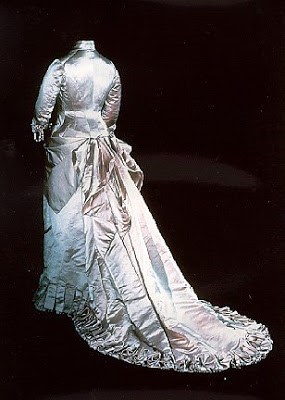
Smithsonian Institution
Inauguration Day, March 4, 1881, began raw and disagreeable, but cleared around noon. Lucretia recalled that the “President stood out before the people and with the inspiration of the time and the occasion lifting him up into his fullest grandeur, he became in the magnificence with which he pronounced his inaugural almost superhuman.” The ball was held at the Smithsonian’s new National Museum building – being completed in 1880 to hold objects from the Centennial Exhibition. Crete was dressed “in lavender satin with trimmings of point lace and a corsage bouquet of pansies.” The first couple received guests until the dancing began at approximately 11:30 p.m. when they retired to the Executive Mansion for their “first night among the shadows of the last 80 years.”
Lucretia’s time as first lady was brief. She kept a diary, established her calling hours for visitors, settled her children into their new schools, and began researching the history and furnishings of the Executive Mansion (White House) at the Library of Congress. She was hostess to several dinners for Cabinet members, ambassadors, military leaders, and their wives. Crete “had to travel fast and think faster” ever since she had known James Garfield, just “to keep within seeing distance.”
Her plans to restore the mansion were never carried out. Lucretia developed life-threatening malaria in May 1881 and had to finish her recuperation at the ocean shores of Long Branch, NJ. It was there that she received the telegram that the President had been shot at the Baltimore and Potomac RR Station and needed her to come to Washington as soon as possible. First lady Lucretia, barely recovered herself, spent the next 80 days caring for her husband. She gained universal admiration for her devotion, strength, and tireless nursing. Despite her heroic efforts, along with those of the President’s doctors and caretakers, the nation’s patient died the evening of September 19th – only 200 days after he took the oath of office. Lucretia cried bitterly, then composed herself to sit quietly, alone, at the bedside of her husband of 22 years.
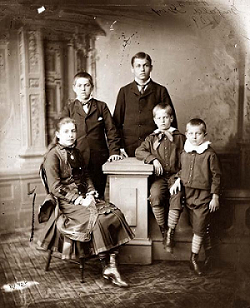
(White House) by Mathew Brady Studio (c. 1881)
Left to right: Mollie, James, Harry, Irvin, Abram
Library of Congress
Widow
The first lady received hundreds of expressions of sympathy: letters, poems, commemorations, and tributes, including a letter of condolence and a funeral wreath of white tuberose from Queen Victoria. After what was called “the funeral of the century” in Cleveland, OH, Lucretia Garfield led a quiet, yet social life in widowhood. Newspapers referred to her as “Discreet Crete” and the “Vanishing First Lady” because she ducked all publicity. She felt that her husband was the famous one – she was merely a woman devoted to family.
Always one to meet adversity head on, Lucretia carried on. Daughter Mollie later said, “…Had it not been that her children needed her more than at any other time in their lives, life would have meant very little to her.” Lucretia’s goals were to raise her five children (who were 8 to 18 years old), to improve the Mentor farm into a country estate, and to keep James A. Garfield’s memory alive. She was the fortunate recipient of a Subscription Fund, started by Cyrus Field and other eastern industrialists, with donations added from ordinary people all over the US. The fund equaling $360,000 ($9 million in today’s money), was put into a NY bank with widow Lucretia periodically receiving the interest money. This allowed her to educate her children and continue living at “Lawnfield.” It also gave her the income to build an addition onto the back of the farmhouse that her husband knew and loved.
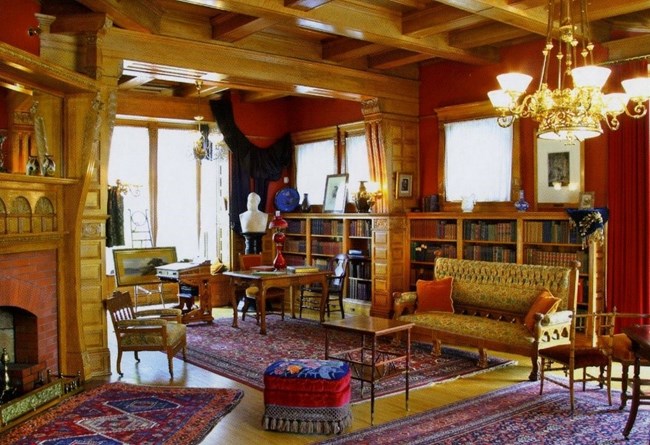
NPS Photo
In 1882, Lucretia purchased the Worthington house on Prospect St. in Cleveland, OH to have Mollie near Miss Mittleberger’s school and to live in the city while the deconstruction and addition took place at the farm from 1885-1886. She created the country’s first presidential Memorial Library with the assistance of architect Forrest Coburn, her older sons Hal and Jim, and Garfield’s former secretary Joseph Stanley-Brown. Brown meticulously collected, collated, and preserved Garfield’s papers, for which a fireproof vault had been constructed at the rear of the Library. The older boys lovingly arranged their father’s books on the shelves in the room. It was a family project. Lucretia dismantled the Cleveland house in the spring of 1886 and moved back to Lawnfield. She later wrote to son Abram:
“I somehow feel that the house is a much more interesting monument to your father’s memory than anything that can be built merely as a monument, and I want it to be worthy of him.”
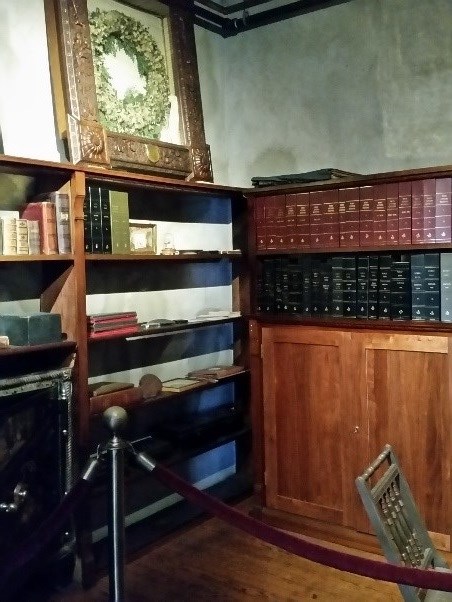
NPS Photo
“When I was a child, my grandmother used to unlock the steel doors of the Memorial Room [Vault] by twirling a “combination” like a safe. We children watched, wide-eyed and fascinated. As the doors swung back, we walked into a close, musty-smelling room, half-lit by pale sunlight filtering down from high windows.
"Toward evening Grandmother would lock the heavy, steel doors, with a sort of satisfied little exclamation, 'There!’ Then she would slowly close the oak-paneled door that concealed the steel ones. And the Memorial Room, we felt, was safe.” ~ Granddaughter Ruth Stanley-Brown Feis - Daughter of Mollie
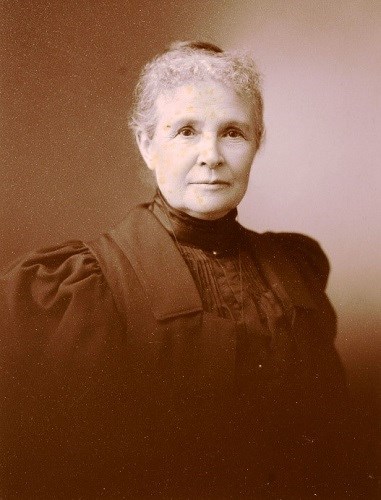
Lake County Historical Society
Grandmother & Family Matriarch
Lucretia R. Garfield outlived her husband by almost 37 years. She was able to see her children educated and married (two of them in the Memorial Library, June 1888), and to enjoy the company of 16 grandchildren. She built a gasholder, after finding natural gas on the farm property, and added gas lights, fireplaces, and cookstove to her home. Other improvements, like a newly-dug well, windmill, and water tank system and an L-shaped carriage house, made the farm into a “country estate” by the late 1890s. In 1900, she and daughter-in-law Helen, hired landscape architect J. Wilkinson Elliott to develop a plan to add driveways, paths, and unusual plantings to embellish the farm and connect the Garfield properties along Mentor Ave. What had started as almost 160 acres of farmland, house, and barns was now an approximately 400-acre “Garfield family compound” consisting of Eastlawn, Lawnfield, Hollycroft, and Willoughbrook Farm.
Lucretia kept her family close. She wrote to the new grandchildren as babies to introduce herself and welcome them into the family. They all liked to gather at Lawnfield during the summer, the little ones getting to know one another well. Christmas was also a family gathering time – the last one in Mentor in December 1898 when the grandchildren enacted a skit about the Rough Riders in the Spanish-American War.
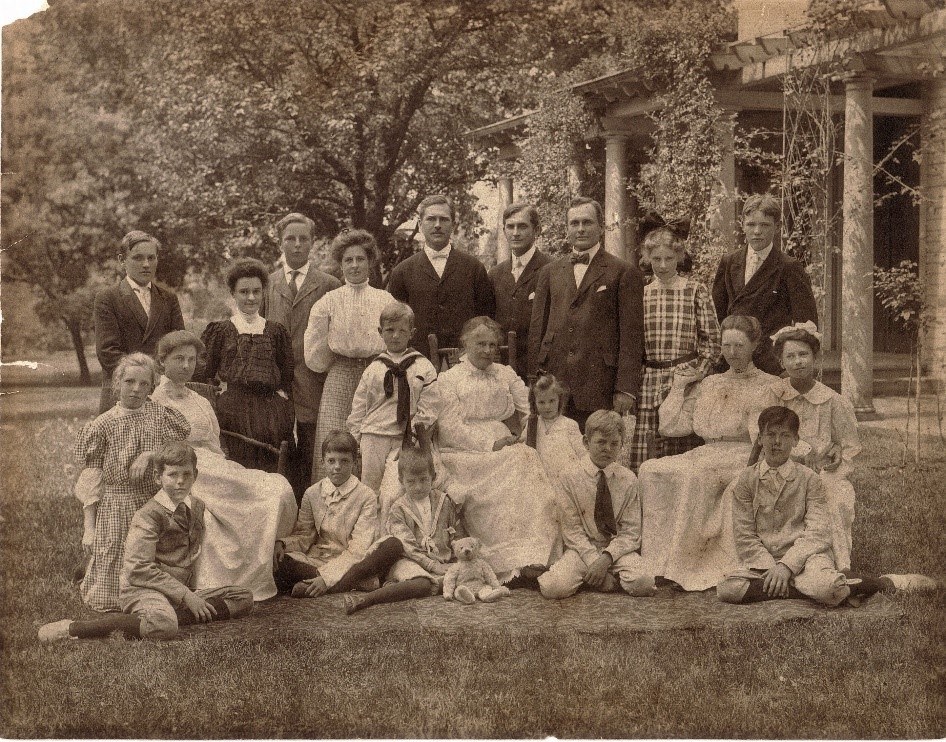
From Strands from the Weaving by granddaughter Lucretia Garfield Comer, 1959
The former first lady enjoyed civic activities, as well. She assisted second son James R., in the establishment of the free public library in Mentor. Lucretia donated books and a piano used when holding entertainments to raise funds for the new building. She also joined daughter Mollie and sister-in-law Lide Rudolph in establishing a ladies’ literary and social club in the area. The “Miscellany Club,” organized in 1898, still exists. Lucretia was a trustee of Hiram College (the former Western Reserve Eclectic Institute) until 1895. She assisted the Red Cross during WWI.
Traveling to New York for the opera season, and to her children’s homes east and west to visit grandchildren, were annual trips. She also began to leave Ohio in the wintertime for warmer climates.
“She was the most wonderful grandmother that any child ever had. You could ask any one of her 16 grandchildren and they would tell you the same thing. Of course, I was sure that I had a special place in her heart because I was named for her. But each one of us felt ‘special,’ because Grandmother just made you feel that way.” ~ Granddaughter Lucretia Garfield Comer, Washington, DC, 1956 – daughter of Harry (Hal)
“It was grandmother who had drawn all the families into one great home circle… where, every summer they met and united as one, each to share his joys with the other.” ~ Granddaughter Mary Louise (Polly) Garfield – daughter of Abram
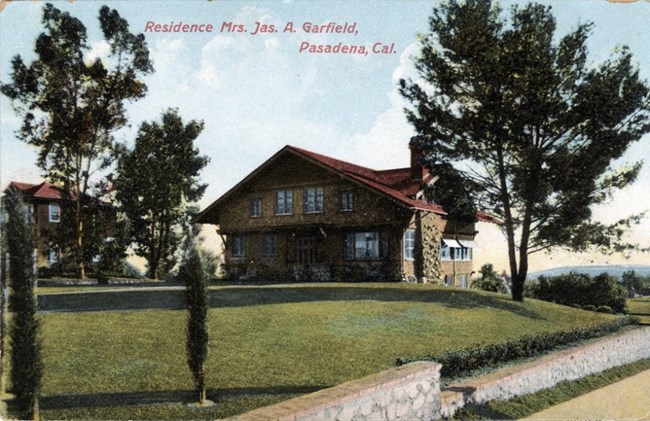
1901 Buena Vista St., S. Pasadena, CA
Historic Postcard
Snowbird
Around the turn of the 20th Century, Lucretia joined other northeastern OH women who traveled west by train to the more tropical climate of southern CA. She first visited Mollie and her family there, then stayed in a luxurious hotel built by the railroad company. She even rented a house on Colorado Blvd. for a couple seasons. Then in 1903-4, Lucretia purchased a corner lot in South Pasadena, CA and had a winter home built by Arts and Crafts’ architects Greene & Greene (who were distant cousins of Lucretia’s). The house resembles a Swiss chalet and overlooks the San Gabriel Mountains and valley. It still exists today and was last sold for approx. $3 million in 2015 by former owners Melanie and Joe Henry - Madonna’s sister and brother-in-law!
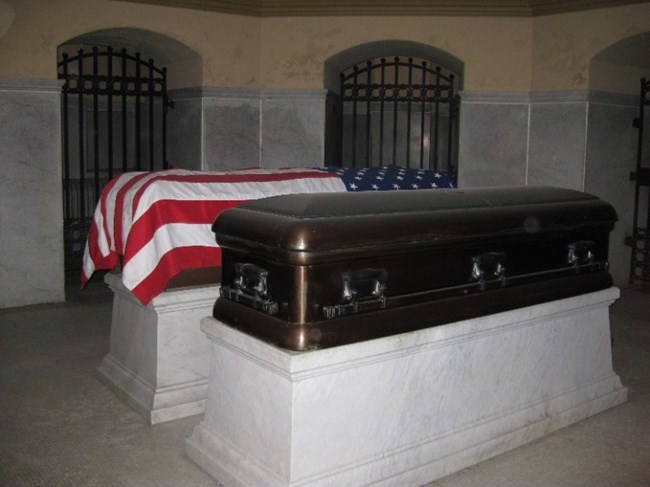
next to her husband’s flag-draped casket
Garfield Memorial - Lake View Cemetery, Cleveland
NPS Photo
Death
Lucretia Rudolph Garfield died of pneumonia after a brief illness at her South Pasadena home on March 13, 1918. Daughter Mollie was at her bedside. The former first lady was just a month shy of her 86th birthday. She was brought back to Cleveland, Ohio and laid to rest beside her husband at Lake View Cemetery.
In her obituary, the Cleveland Plain Dealer wrote, “She gave her heart to her children and as they worked out their destinies, she devoted herself to charity and helpful acts of kindness that endeared her to many.”
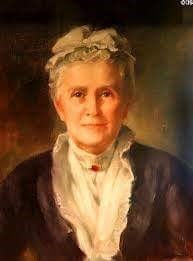
Commissioned by daughter Mollie Garfield Stanley-Brown
Painted by John F. Folinsbee, c. 1920s
NPS
Despite the tragedies in her life, Lucretia Rudolph Garfield continued to have a hopeful outlook. She taught her children and grandchildren, by example, how to live and grow old gracefully. Throughout her long life, Lucretia continued to be interested in art, literature, science, religion, education, politics, and current events. She accomplished much in her 86 years, from farm girl to First Lady, to family matriarch. She had 5 surviving children, 16 grandchildren, and 45 great-grandchildren. The current generations continue to visit JAGNHS and learn more about their heritage.
“My five children have been a continual joy and inspiration to me. And with the memory of my dear Husband and our little ones who didn’t stay very long… I have had a remarkable life. For does not life grow richer as the years go on? Even our losses lead us into wider fields and nobler thoughts.”
Return to part 1 of Lucretia Rudolph Garfield: A Remarkable Life.
Written by Debbie Weinkamer
Lead Volunteer ~ James A. Garfield NHS & Portrayer of Lucretia R. Garfield
February 2021
Sources:
Crete and James: Personal Letters of Lucretia and James Garfield; John Shaw; Michigan State University Press; MI; 1994
Lucretia: A Volume in the Presidential Wives Series; John Shaw; Nova History Pub., NY; 2004
Lucretia Rudolph Garfield: Encyclopedia of First Ladies; Ann Heinrichs; Children’s Press – Grolier Pub.; NY; 1998
The Life & Letters of James Abram Garfield; Theodore Clarke Smith; Yale University Press; CT; 1925
